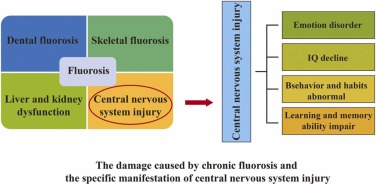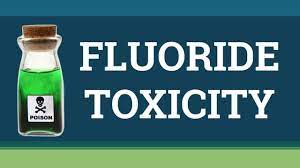How the problem began
About a hundred years ago, in village in Colorado children were born with stained brown teeth. After investigating this, dentists and scientists discovered that the children had high amounts of fluoride in their drinking water. They also discovered these children had very few cavities. Fluoride levels were lowered, and the new generations continued to have fewer cavities. This news spread over the country and thus began the fluorination of drinking water.
Note: Fluoride is not needed for ANY natural biochemical process in the human body.
The toxicity of fluoride
When fluoride is ingested, 50% is detoxed through the kidneys and the rest is stored in various tissues, such as thyroid, bones, teeth, and brain.
The toxicity of an accumulation of fluoride in the body has been studied well for over 50 years. Studies reveal that the nervous system is sensitive to fluoride, in other words, fluoride causes changes in the brain cells. Fluoride can accumulate in the brain after crossing the blood brain barrier (BBB), causing functional and structural changes in animal and human brain tissues. (Holland, 1979).
Specific experiments revealed that the fluoride concentration increased in the hippocampus, and the cerebral cortex. It has been found especially harmful to neonates and children. It causes learning and memory issues and other cognitive deficits such as significantly lower IQ. In addition, it’s found that those with excess fluoride have mental health issues such as tension, anxiety, and depression.
Wilson and DeEds 1940; Susheela et al. 2005 discovered that the thyroid gland is effected by fluoride. The fluoride interferes with the pituitary gland in the brain, and inhibits the release of the thyroid stimulating hormone. It also blocks the receptors on the thyroid cells. So less than optimal thyroid function is most likely happening if you are exposed to fluoride.

There are many mechanisms at play in the toxic effect including damage to the myelin sheath of the nerves, an imbalance in the neurotransmitters and their receptors, damage to the mitochondria, and higher levels of oxidative stress in the nervous system and brain.

Testing for fluoride in your body is a good idea.
Fluoride levels are measured in the urine test by Doctor’s Data, who offers a 24-hour urine collection test to assess your levels. An alarming fact is, only half of the absorbed fluoride in adults will leave the body via the urine, the rest will store in the body, brain, teeth and bones. The normal range for this test is a fluoride level of fewer than 1.1 milligrams (mg).
Avoidance is key
Toothpaste typically contains 1.3mg of fluoride per ¼ teaspoon. Fluoride from toothpaste is well absorbed into the blood stream. Trace amounts do enter the body depending on how well one spits and rinses during and after brushing and how many times per day one uses products containing fluoride. Use fluoride free toothpaste is a good idea.
Food. Surprisingly over 60% of our fluoride comes from food sources. The highest levels are found in brewed tea and seafood. Next is raisins, oats, grapefruit juice and russet potatoes. Organic foods contain less fluoride. There are higher amounts in flavored beverages, fruit juices and processed meats.
Water. In the US, over 70% of our drinking water is fluorinated. Its’s a good idea to check if your city or state adds fluoride to the water supply. To remove fluoride from your water, use reverse osmosis water filters. For a good counter top or under the sink filter system, I recommend Aquabelle.
Also bottled water can be contaminated, avoid these brands.
- Arrowhead
- Deer Park
- Crystal Rock
- Sierra Springs
- Zephyrhills
- Ice Mountain
- Crystal Springs
- Belmont Springs
- Poland Springs
- Mount Olympus
- Diamond Springs
Teflon coated non-stick pans. Throw them out. The toxins they contain in the coating are know as Per-fluorinated compounds (PFC’s) and they leach out into your food during the cooking process. In addiction to increasing your fluoride exposure, they increase cancer risk, contribute to infertility, negatively affect the immune system and the making of thyroid hormone.
How do I detox from fluoride?
Eat an organic whole foods diet and include the following nutrients in food or supplements.
Vitamin C, as an antioxidant, it helps your body deal with the oxidative damage caused.
Calcium is valuable to bind to fluoride ions so they can be flushed out of the body. Calcium can be supplemented or we can get it from foods like cooked dark leafy greens, and fish with bones.
Vitamin D helps the body absorb calcium. We can get vitamin D from the sun but it takes a lot of sun to get our daily dose. Full body sun exposure for 20 minutes per day gives us 5000iu and our body uses this much daily. So supplementing is a good idea, 2-4000iu daily is perfect for most people, some need more, others need less. Foods that contain vitamin D include wild salmon, and sardines.
Iodine is great at knocking out the fluoride. They are both ‘halides’ so iodine can replace fluoride easily. It is best taken from food sources such as organic kelp flakes. It will help with thyroid function as well. Too much iodine can alter thyroid functioning so I would stick to food sources. 1/4 to 1/2 tsp of kelp flakes can be added to any food every day. If you want to take iodine supplements, it’s recommended to have your thyroid levels tested before you begin and during the time you are taking it.
“Fluoride seems to fit in with lead, mercury, and other poisons that cause chemical brain drain. The effect of each toxicant may seem small, but the combined damage on a population scale can be serious, especially because the brain power of the next generation is crucial to all of us.” (Grandjean from Harvard School of Public Health website),
Hope this helps!


